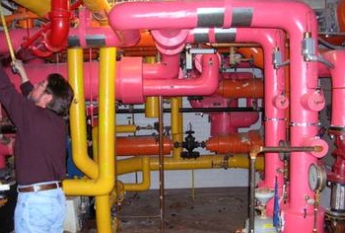Energy Audit Services
Get a Comprehensive Understanding
An Energy Audit is a comprehensive evaluation and analysis of a building’s current energy use and identifies alternatives for reducing energy costs without impacting the current level of comfort or productivity within the facility. The number one goal of an energy audit is to maintain the proper level of the indoor environment (comfort, temperature, humidity, ventilation, production rate, etc.). The number two goal is to achieve the first goal at the lowest possible cost for energy. The quality of the indoor environment should not be sacrificed in an attempt to reduce energy costs.
Energy audits are often confused with Existing Building Commissioning (EBCx). The main difference between energy audits and EBCx is the Current Facility Requirements (CFR). With EBCx, the CFR drives the project by identifying what the current needs of the facility are, which may be drastically different than what the original needs and design were when the facility was constructed. With energy audits, reducing energy consumption and costs drives the project.
If a facility has widespread comfort complaints or serious Indoor Air Quality (IAQ) issues then EBCx should be the service considered in lieu of an energy audit.
Results from energy audits provide a roadmap that identifies the most appropriate energy-saving opportunities for a single building or group of buildings in a larger facility such as a military base, hospital complex, K-12 school, or university. Energy audits alone do not decrease energy usage, as energy-saving strategies must actually be applied in order to see results. However, the implementation of these cost-effective opportunities can result in a payback period typically ranging from six months to four years, depending on many factors such as energy costs, hours of operation, estimated savings, and implementation costs. Blending fast payback measures with major capital improvement measures helps reduce the total payback when deeper building retrofit projects are being considered.
EBCx Services Has a Broad Range of Experience Performing Energy Assessments/audits (ASHRAE Level 1, 2, 3) and Targeted Energy Assessments of Complex HVAC&R Systems.
We are experienced in facilities ranging from military bases, prisons, office buildings, healthcare, k-12 schools, universities, pharmaceutical manufacturing facilities, industrial process plants, and aviation.
Benefits of an Energy Audit:
ASHRAE has developed and organized different levels of energy audits to provide the industry with a range of choices when a building owner or facility manager is deciding to have an energy audit performed at their facility. As a result, the levels of effort have been organized into the following categories:
Below Is a Brief Overview of Each Type of Energy Audit
Preliminary Energy-Use Analysis (PEA)
Level 1
Includes all of the work performed for the PEA
Perform a brief walk-through survey of the facility to become familiar with its construction, equipment, operation, and maintenance
ook for obvious (low-hanging fruit) measures
Provide a list of low-cost measures with initial rough estimated costs and savings
Level 2
Includes all of the work performed for the Level 1 audit
Review mechanical and electrical drawings, installed condition, maintenance practices, and operating methods
Perform a detailed walk-through of the facility
Perform necessary testing of equipment and systems to establish an as-found condition for accurate energy calculations to be performed
Disaggregate energy use by on-site observation, measurements, and engineering calculations
Identify available financial incentives, rebates, grants, and low-interest financing
Identify Energy Conservation Measures (ECM), both low-cost and capital improvements
Provide initial rough estimated costs and savings
Meet with customer and stakeholders, review ECM list and prioritize measures, bundle measures as appropriate
Finalize ECM budget costs and estimated savings, and appropriate financial metrics
Level 3 - Also Known as an Investment Grade Audit (IGA)
Includes all of the work performed for the Level 2 audit
Detailed testing, modeling of equipment to gain a higher degree of confidence in energy savings
Rigorous engineering evaluations that provide a high level of confidence for major capital improvement decisions
More detailed field data may be required to support the required engineering analysis
Targeted
EBCx Services understands how to effectively perform energy audits in a cost-effective manner for our clients. If you are interested in reducing energy costs at your facility, please contact us for additional information.
Contact EBCx Services for information on how to reduce energy costs at your facility

EBCx Services holds the following certifications through the Association of Energy Engineers (AEE):

An important part of performing an energy audit is verifying that equipment and controls operate correctly.

Building Automation Systems (BAS) provides significant energy savings with attractive paybacks. Often the only costs are minor programming and set-point changes.

Replacing inefficient equipment provides both energy and maintenance/repair cost savings.

Replacement of existing equipment (retrofits) must be planned carefully to determine both estimated energy savings and construction costs.
